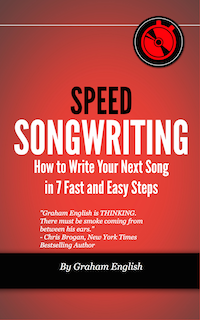
Flood Your Sketchbook with Tunes Using These Proven, No-Fluff Methods
If you're only writing a handful of melodies each week, you're bottlenecking your creativity. The problem isn’t talent—it’s throughput.
You don’t need better ideas. You need more ideas. Volume breeds quality. The more melodies you create, the faster you stumble into the gold.
So the question isn’t, can you write 100 melody ideas a week—it’s how fast can you start?
Here’s how to hit that number without burning out or writing garbage. These four techniques will get your brain working faster, your fingers moving with purpose, and your idea bank overflowing.
Let’s go.
1. The 5x20 Sprint Method
Write 20 melodies a day. Five days a week. That’s 100 melodies. Done.
Sound impossible? It’s not. Each sprint lasts 10 minutes.
You don’t need a complete melody. You need an idea: a 4-bar phrase, a hummable loop, a motif that sticks.
Set a timer for 10 minutes. Open Voice Memos, or record directly into Logic or GarageBand. Now go. Sing. Play. Hum. Don’t stop until the timer ends.
Do five 10-minute sprints each day. That’s 20 short melodies—most will be trash. A few will be decent. One or two might knock you sideways.
Here’s what one session might sound like:
- A 2-bar vocal riff using only three notes
- A fast, choppy melody over a minor 7 groove
- A legato piano phrase that climbs, pauses, and drops
- A whistle-style tune you could build a pop hook on
- A motif you stole from your dog’s bark rhythm (no shame)
You're not trying to write a song. You're sketching raw melodic shapes.
By Friday, you’ll have 100 ideas. That’s a vault most songwriters never build.
2. The Limitation Generator
Creativity explodes when you restrict it. Constraints force focus.
Here’s how to generate endless melody variations using 4 tight rules. Use one at a time—or stack them.
Try this:
- Only 3 notes allowed (e.g., G-A-B)
- Must use a dotted rhythm (like dotted eighths and sixteenths)
- Has to fit inside 1 octave
- Start on beat 2 (not beat 1)
Suddenly, you’re not staring into the abyss—you’re solving a melodic puzzle. And your brain loves puzzles.
You’ll be shocked how many usable ideas show up when you’re only allowed 3 notes and a weird time offset.
Keep a running doc of your favorite “limitation formulas” and rotate through them during your sprints. This keeps things fresh, fast, and fun.
3. Steal + Twist
The pros steal like artists. They just don’t stop at stealing—they twist the idea until it sounds brand new.
Pick 5 songs a day—any genre. Transcribe one short melody or riff from each—just 4–8 bars.
Then mutate it.
- Invert the contour (if it goes up, make it go down)
- Change the rhythm but keep the note intervals
- Move it to a different key and mode
- Double it, reverse it, halve it
Here’s how that works:
Let’s say you pull the opening melody from “Levitating” by Dua Lipa. You flip it rhythmically, shift the first note up a fifth, and suddenly it’s not Dua—it’s yours.
Do that five times a day. That’s 35 “stolen-then-twisted” melodies every week.
4. The 10x10 Grid
Templates make you faster. Here’s one to automate your idea generation.
Create a 10x10 melody grid. Across the top, list 10 different emotions or story prompts:
- Triumph
- Longing
- Playfulness
- Suspense
- Nostalgia
- etc.
Down the side, list 10 musical textures or performance techniques:
- Staccato
- Gliding
- Syncopated
- Arpeggiated
- Monotone
- etc.
Now pick one box at a time:
“Playfulness + Staccato” = write a short, bouncy melody that sounds like mischief.
“Longing + Arpeggiated” = write a flowing piano line that pulls upward but never resolves.
Each box = 1 melody idea. That’s 100 right there.
To get started, build your own 10x10 melody matrix. Don’t overthink it—just write what feels fun. Then fill in the grid over the next 7 days.
Final Note: Track Your Ideas Like a Scientist
All this work means nothing if you lose track of your ideas. Start a Melody Vault: one folder, one naming system. Label them by date, mood, vibe, whatever works.
Each Sunday, review your 100. Flag the top 10. Build songs from the top 3.
That’s how you go from busy to prolific.
TL;DR
- Use the 5x20 Sprint Method to rack up quantity
- Apply limitations to force new shapes
- Steal and twist melodies to learn and mutate
- Use a 10x10 Grid to prompt variety
- Organize everything so nothing gets lost
Flood your sketchbook. Drown it in melody.
100 ideas a week isn’t just possible—it’s inevitable when you stop waiting for inspiration and start running systems.
Let your creativity catch up later. For now, write.

Enter your first name and email address below and click “GET ACCESS NOW!” to get the Speed Songwriting Cheat Sheet delivered to your inbox!
We guarantee 100% privacy. Your information will not be shared.

Superb Graham . Thank you. You never stop coming up with brilliant ideas for cracking creativity open.
Thanks so much! I’m just here to help you unlock what’s already in you. More to come!
Thank you thank you! I love your emails!
You’re welcome! I appreciate the feedback.
Great article Graham! I have so much trouble getting started, but this helps-especially limitations. They help me focus.
Bill Dennett.
Thanks Bill! Limitations are a game changer. Glad this helped you focus.